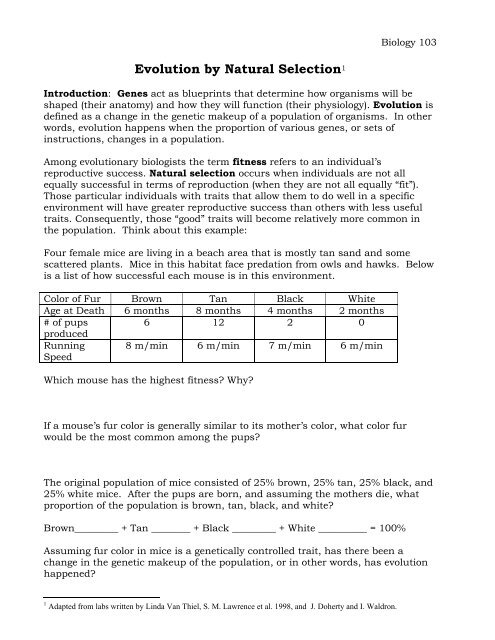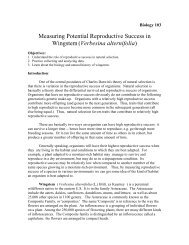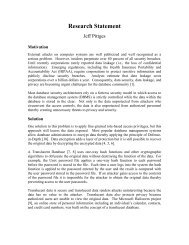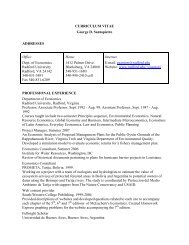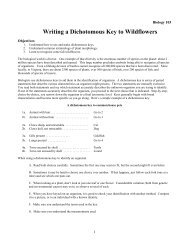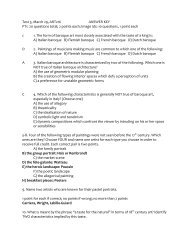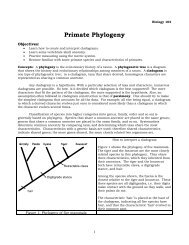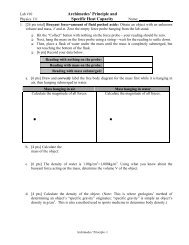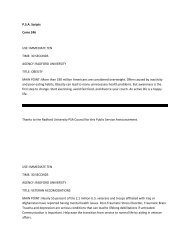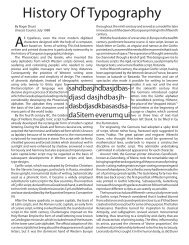Evolution by Natural Selection - A Simulation
Evolution by Natural Selection - A Simulation
Evolution by Natural Selection - A Simulation
- No tags were found...
Create successful ePaper yourself
Turn your PDF publications into a flip-book with our unique Google optimized e-Paper software.
Biology 103<br />
<strong>Evolution</strong> <strong>by</strong> <strong>Natural</strong> <strong>Selection</strong> 1<br />
Introduction: Genes act as blueprints that determine how organisms will be<br />
shaped (their anatomy) and how they will function (their physiology). <strong>Evolution</strong> is<br />
defined as a change in the genetic makeup of a population of organisms. In other<br />
words, evolution happens when the proportion of various genes, or sets of<br />
instructions, changes in a population.<br />
Among evolutionary biologists the term fitness refers to an individual’s<br />
reproductive success. <strong>Natural</strong> selection occurs when individuals are not all<br />
equally successful in terms of reproduction (when they are not all equally “fit”).<br />
Those particular individuals with traits that allow them to do well in a specific<br />
environment will have greater reproductive success than others with less useful<br />
traits. Consequently, those “good” traits will become relatively more common in<br />
the population. Think about this example:<br />
Four female mice are living in a beach area that is mostly tan sand and some<br />
scattered plants. Mice in this habitat face predation from owls and hawks. Below<br />
is a list of how successful each mouse is in this environment.<br />
Color of Fur Brown Tan Black White<br />
Age at Death 6 months 8 months 4 months 2 months<br />
# of pups<br />
6 12 2 0<br />
produced<br />
Running<br />
Speed<br />
8 m/min 6 m/min 7 m/min 6 m/min<br />
Which mouse has the highest fitness? Why?<br />
If a mouse’s fur color is generally similar to its mother’s color, what color fur<br />
would be the most common among the pups?<br />
The original population of mice consisted of 25% brown, 25% tan, 25% black, and<br />
25% white mice. After the pups are born, and assuming the mothers die, what<br />
proportion of the population is brown, tan, black, and white?<br />
Brown_________ + Tan ________ + Black _________ + White __________ = 100%<br />
Assuming fur color in mice is a genetically controlled trait, has there been a<br />
change in the genetic makeup of the population, or in other words, has evolution<br />
happened?<br />
1 Adapted from labs written <strong>by</strong> Linda Van Thiel, S. M. Lawrence et al. 1998, and J. Doherty and I. Waldron.
The above example demonstrates the three prerequisites for evolution <strong>by</strong> natural<br />
selection:<br />
1) Individuals have different traits.<br />
2) Offspring tend to have the same traits as their parents (traits are heritable).<br />
3) Traits determine individual’s fitness.<br />
Whenever these three things are true, not all individuals are going to be equally<br />
fit. That means some will reproduce more than others, and the traits of those most<br />
fit individuals will become more common in the population in the following<br />
generations….evolution will happen.<br />
Methods: We are going to simulate a real-world example of evolution <strong>by</strong> natural<br />
selection. Predators profoundly influence the survival of their prey, and because<br />
the traits of prey individuals determine how likely they are to become lunch to a<br />
predator, predators can be a strong force driving the evolution of prey organisms.<br />
In our simulation students will act as the predators and will “feed” on dried beans.<br />
Not all beans will have the same traits – they will vary in size and shape and color.<br />
We will see if the predators “select” for prey with certain traits, and whether the<br />
population of prey organisms changes through time. To make things more<br />
interesting, we are going to conduct this simulation in different environments and<br />
with different predator types. Will populations in different environments or facing<br />
different predators evolve in the same way or in opposite ways????<br />
Foraging Rules:<br />
1. Use utensils only – NO HANDS!<br />
2. Beans can only be captured one at a time – no mass capture!<br />
3. A captured bean must be placed into the predator’s cup before it counts –<br />
and before the predator can continue foraging.<br />
4. Any dropped bean is replaced in the habitat.<br />
5. Predators can’t directly interfere with other predators.<br />
<strong>Simulation</strong> Instructions:<br />
1) Randomly distribute the prey (the beans) across your habitat (either white<br />
paper {artic tundra}, or multi-colored rug {prairie}).<br />
2) Pick three people to be predators; each should grab a utensil (fork, knife, or<br />
spoon). Pick one person to watch the clock.<br />
3) The timekeeper says “begin” and allows the predators to forage for three<br />
minutes.<br />
4) Each predator should count and record how many prey of each type they<br />
captured in Tables 1-3 (depending on what generation you are on). The<br />
group should fill in the rest of the table.<br />
5) Take your data to your instructor, who will calculate how many prey of each<br />
type will be born into the population this generation. The number of births<br />
of each type is proportional to the number that still remain in your<br />
population (for instance, if the population after your foraging is now 50%<br />
peas and 50% black beans, the new births will be 50% peas and 50% black<br />
beans).
6) Put the appropriate number (what it says on the sheet your instructor gives<br />
you) of beans of each type back into the habitat.<br />
7) Return to step 2.<br />
Table 1. First Generation.<br />
Predator Number of Each Prey Type Killed <strong>by</strong> the Predators<br />
Type Black White Pea Pinto TOTAL<br />
Knife<br />
Fork<br />
Spoon<br />
TOTAL *<br />
*Total number of prey caught <strong>by</strong> all predators.<br />
Table 2. Second Generation.<br />
Predator Number of Each Prey Type Killed <strong>by</strong> the Predators<br />
Type Black White Pea Pinto TOTAL<br />
Knife<br />
Fork<br />
Spoon<br />
TOTAL *<br />
*Total number of prey caught <strong>by</strong> all predators.<br />
Table 3. Third Generation.<br />
Predator Number of Each Prey Type Killed <strong>by</strong> the Predators<br />
Type Black White Pea Pinto TOTAL<br />
Knife<br />
Fork<br />
Spoon<br />
TOTAL *<br />
*Total number of prey caught <strong>by</strong> all predators.<br />
Table 4. The abundance of each prey type in the population through time.<br />
Generation<br />
#<br />
Abundance of Each Prey Type at the Beginning of Each<br />
Generation<br />
Black White Pea Pinto TOTAL<br />
1 150 150 150 150 600<br />
2<br />
3<br />
4
Answer the questions below on a separate sheet:<br />
1.) What prey type became the most common in the “prairie” habitat? In the<br />
“artic tundra” habitat? Why did those prey types succeed in their<br />
environments?<br />
2.) What do you think would happen to the prey populations if we ran our<br />
simulations for 50 generations?<br />
3.) Did any individual beans change from being peas to black beans, or from<br />
being white beans to being pinto beans? If they had, what biological process<br />
would that represent?<br />
4.) Could evolution <strong>by</strong> natural selection have happened if all of the beans were of<br />
one type (e.g., all pinto beans)?<br />
5.) What predator type (e.g., knife, fork, spoon) was most effective in each<br />
habitat? If predator populations were represented more realistically in our<br />
simulation, with births and deaths being dependent on feeding success, what<br />
would have happened to the predator population?<br />
6.) What do you think would have happened to the prey (bean) population if the<br />
predators had been blindfolded?


